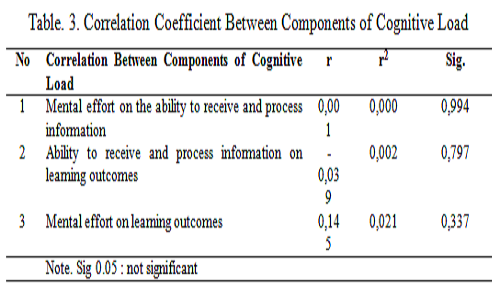
Cognitive Load Lecture on Diversity and Classification of Vertebrates Through Moodle-Based Online Learning
Abstract
Keywords
Full Text:
PDFReferences
Aminah, G. H. (2018). Sumber Belajar Materi Animalia Kelas X DI MA NU 03 Sunan Katon (Pengembangan Buku Identifikasi Vertebrata Koleksi Kebun Binatang Mangkang Sebagai Sumber Belajar Materi Animalia Kelas X di MA NU 03 Sunan Katong ). Jurnal Pedagonal, 1–90.
Arikunto, S. (2007). Dasar-Dasar Evaluasi Pendidikan (Revisi). Bumi Aksara.
Brunken, R., Seufert, T., & Paas, F. (2010). Measuring Cognitive Load. In J. L. Plass, R. Moreno, & R. Brunken (Eds.), Cognitive Load Theory (pp. 181–201). Cambridge University Press.
Cahyani, A., Listiana, I. D., & Larasati, S. P. D. (2020). Motivasi Belajar Siswa SMA pada Pembelajaran Daring di Masa Pandemi Covid-19. IQ (Ilmu Al-Qur’an): Jurnal Pendidikan Islam, 3(01), 123–140. https://doi.org/10.37542/iq.v3i01.57
de Jong, T. (2010). Cognitive load theory, educational research, and instructional design: Some food for thought. Instructional Science, 38(2), 105–134. https://doi.org/10.1007/s11251-009-9110-0
Kahfi, A. (2021). Dampak Pembelajaran Daring Di Masa Pandemi Covid 19 Terhadap Perkembangan Kognitif Anak. Jurnal Dirasah, 4(1), 14–23.
Mayer dan Moreno. (2010). Techniques That Reduce Extraneous Cognitive Load and Manage Intrinsic Cognitive Load during Multimedia Learning. In J. L. Plass, Moreno, & Brunken (Eds.), Cognitive Load Theory (p. 131). Cambridge University Press.
Muamanah, H., & Suyadi. (2020). Pelaksanaan Teori Belajar Bermakna David Ausubel Dalam Pembelajaran Pendidikan Agama Islam. Jurnal Pendidikan Islam, 5(01), 161–180. https://doi.org/10.29240/belajea.v5
Munandar, R. R. (2015). Pengelolaan Beban Kognitif Siswa Sesuai Gaya Belajar Dan Sosial Ekonomi Menggunakan Pembelajaran Two Stay Two Stray Pada Materi Klasifikasi Spermatophyta. Universitas Pendidikan Indonesia.
Nursit, I. (2015). Pembelajaran Matematika Menggunakan Metode Discovery Berdasarkan Teori Beban Kognitif. JPM : Jurnal Pendidikan Matematika, 1(1), 42. https://doi.org/10.33474/jpm.v1i1.403
Paas, F., Renkl, A., & Sweller, J. (2003). Cognitive load theory and instructional design: Recent developments. Educational Psychologist, 38(1), 1–4. https://doi.org/10.1207/S15326985EP3801_1
Putri, I. I. (2018). Hubungan Komponen Usaha Mental (UM) Dan Menerima Mengolah Informasi (MMI) Pada Proses Pembelajaran Biologi. Bioilmi: Jurnal Pendidikan, 4(2), 53–61.
Rahmawati, L. E., & Setyaningsih, V. I. (2021). Kemandirian belajar siswa dalampembelajaran daring mata pelajaran bahasa Indonesia. Kembara: Jurnal Keilmuan Bahasa, Sastra Dan Pengajarannya, 7(2), 353–365. https://doi.org/10.22219//kembara.v7i2.16326
Rizvialdi, & Sidarta, N. (2019). Pengaruh aktivitas fisik terhadap kapasitas memori kerja pada pelajar SMA. Jurnal Biomedik Dan Kesehatan, 2(2), 58–64.
Siki, F. (2019). Problematik Strategi Pembelajaran Bahasa Indonesia. Jubindo: Jurnal Ilmu Pendidikan Bahasa Dan Sastra Indonesia, 4(2), 71–76. https://doi.org/10.32938/jbi.v4i2.213
Sunawan, S., Yani, S. Y. A., Kencana, T. I., Anna, C. T., Mulawarman, & Sofyan, A. (2017). Dampak Efikasi Diri terhadap Beban Kognitif dalam Pembelajaran Matematika dengan Emosi Akademik sebagai Mediator. Jurnal Psikologi, 44(1), 28. https://doi.org/10.22146/jpsi.22742
Suriadi, H. J., Firman, & Ahmad, R. (2021). Analisis Problema Pembelajaran Daring Terhadap Pendidikan Karakter Peserta Didik. Edukatif: Jurnal Ilmu Pendidikan, 3(165–173).
Susanto dan Munandar. (2017). Model Project Based Learning Sebagai Upaya Mengelola Cognitive Load Mahasiswa Semester V Pada Materi Media Audio Visual. Jurnal Ilmiah Pendidikan, 1(2), 100–109.
Wahyuni, S., & Cahyani, Y. (2021). Beban Kognitif Mahasiswa dalam Pembelajaran Daring di Masa Pandemi Covid-19. Jurnal Penelitian Kesehatan Suara Forikes, 12(April), 21–26.
Wantika, R. R. (2017). Pembelajaran Kooperatif Tipe TAI Berdasarkan Teori Beban Kognitif. Jurnal Buana Pendidikan, 13(23), 43–48.
Wardika, K. W., Ariawan, K. U., & Arsa, P. S. (2017). Penerapan Model Core (Connecting, Organizing, Reflexting, Extending) Meningkatkan Hasil Aktivitas Belajar Perakitan Komputer Kelas XTkj2. Jurnal Pendidikan Teknik Elektro Undiksha, 6(3), 127–136. https://ejournal.undiksha.ac.id/index.php/JJPTE/article/view/20856
DOI: http://dx.doi.org/10.31258/jes.6.1.p.107-115
Refbacks
- There are currently no refbacks.
Copyright (c) 2022 Rifki Risma Munandar, Teti Rostikawati, Lufty Hari Susanto

This work is licensed under a Creative Commons Attribution 4.0 International License.
Publisher: FKIP Universitas Riau













